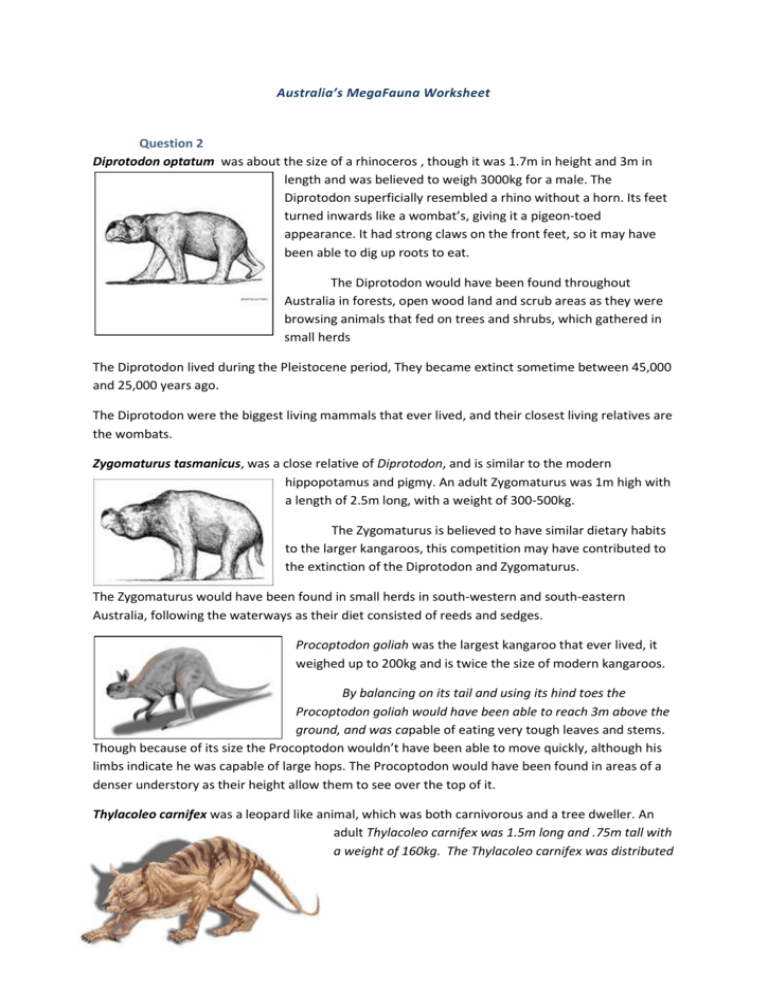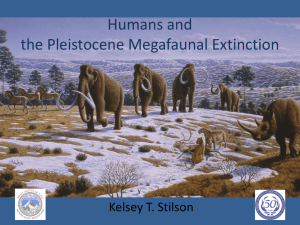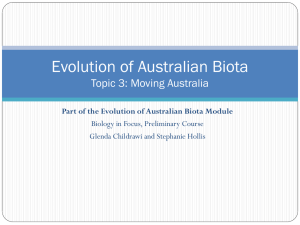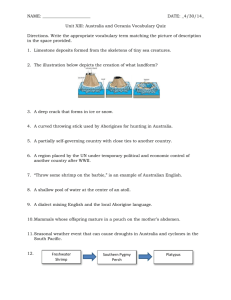Australia`s Mega fauna was unique in the way that it
advertisement

Australia’s MegaFauna Worksheet Question 2 Diprotodon optatum was about the size of a rhinoceros , though it was 1.7m in height and 3m in length and was believed to weigh 3000kg for a male. The Diprotodon superficially resembled a rhino without a horn. Its feet turned inwards like a wombat’s, giving it a pigeon-toed appearance. It had strong claws on the front feet, so it may have been able to dig up roots to eat. The Diprotodon would have been found throughout Australia in forests, open wood land and scrub areas as they were browsing animals that fed on trees and shrubs, which gathered in small herds The Diprotodon lived during the Pleistocene period, They became extinct sometime between 45,000 and 25,000 years ago. The Diprotodon were the biggest living mammals that ever lived, and their closest living relatives are the wombats. Zygomaturus tasmanicus, was a close relative of Diprotodon, and is similar to the modern hippopotamus and pigmy. An adult Zygomaturus was 1m high with a length of 2.5m long, with a weight of 300-500kg. The Zygomaturus is believed to have similar dietary habits to the larger kangaroos, this competition may have contributed to the extinction of the Diprotodon and Zygomaturus. The Zygomaturus would have been found in small herds in south-western and south-eastern Australia, following the waterways as their diet consisted of reeds and sedges. Procoptodon goliah was the largest kangaroo that ever lived, it weighed up to 200kg and is twice the size of modern kangaroos. By balancing on its tail and using its hind toes the Procoptodon goliah would have been able to reach 3m above the ground, and was capable of eating very tough leaves and stems. Though because of its size the Procoptodon wouldn’t have been able to move quickly, although his limbs indicate he was capable of large hops. The Procoptodon would have been found in areas of a denser understory as their height allow them to see over the top of it. Thylacoleo carnifex was a leopard like animal, which was both carnivorous and a tree dweller. An adult Thylacoleo carnifex was 1.5m long and .75m tall with a weight of 160kg. The Thylacoleo carnifex was distributed throughout Australia and is believed to prey on animals much bigger than itself such as the Diprotodon. It is believed that the Thylacoleo carnifex had the strongest bite compared to any living or extinct animals. Zaglossus hacketti was a sheep sized echidna and a length of 1m. The Zaglossus hacketti also had a long snout that curved downwards and it was about three times larger than the modern echidna. It is believed to be the biggest monotreme. The Zaglossus hacketti diet consisted of termites, worms, grubs and beetles. Dromornis stirtoni was the biggest bird that ever lived. It was a flightless bird that weighed over 500kg and stood nearly 3m tall. Also it is suggested that the Dromornis stirtoni were relatively fast runners, due to their large muscled legs which would provide the power. Although they looked like giant emus, the Dromornis stirtoni are more closely related to geese. Also they are sometimes referred to as Mihirung birds The diet of the Dromornis stirtoni is debatable, some paleontologists are convinced they were herbivores (eating mainly tough-skinned fruits and seed pods), but others think at least some dromornithids may have eaten meat, based on the shape and size of their skulls and beaks. Megalania prisca was an giant goanna like carnivore, with a length of 5.5m long and weighing 600kg. The Megalania prisca used its claws for tearing the flesh, within the Megalania prisca mouth was a collection of large, curved, serrated teeth used to rip its prey to shreds. The technique used to detect its prey is similar to modern day reptiles, which by the use of a fork like tongue, flicks it out to detect rotting carcasses 8km away. It is believed that the Megalania prisca lived in open woodlands and grasslands and would have preyed upon both Diprotodons’ and Zygomaturus’s. Question 3 Ekaltadeta Ima was believed to be a Powerful Toothed Giant Rat Kangaroo, which was 20kg in weight and was 1.5m in height. It is believed that Ekaltadeta Ima was an omnivore. By referring to the image below, it demonstrates the dangerous incisors and serrated carnassials, which would have enabled it to kill and consume its prey efficiently. The Palorchestes azael was approximately 2.5m in length, and the height of a horse. The Palorchestes azael was a herbivorous mammal, which would have used its large claws to pull down leaves and strip bark from trees. The Palorchestes azael was initially thought to have been a common ancestor of the modern day kangaroo, due to the similarity in the cheek bone, though, the latin name means “ancient leaper”. Question 4 Question 5 Australia’s Mega fauna was unique in the way that it was the prime candidate for domestication. With these domesticated megafauna there would have been a whole new development for aborigines and Australia. As domesticated animals provide both a sufficient source of protein compared to wild animals. Also other domesticated animals provide a source of power; fertiliser and can also provide clothing which then creates a natural cycle. Domestication had proved so successful in other continents. However, with the extinction of the megafauna, Aborigines were left with no readily domesticable animals. By the time Europeans arrived in Australia, a relatively small population of Aborigines was consuming the majority of animal protein in Australia and, through fire farming, was almost certainly consuming more of the edible grasses and grains than all the other herbivores. With domesticated animals and crops the story could have been quite different. Question 6 The megafauna that were found on Australia were significantly different to other continents, due to the separation from Antarctica. From this isolation the marsupials that were living there became mostly free from competition, which allowed the placental animals to rapidly diversify in contrast to other organisms throughout the world. Question 7 Due to the recent discovery of a Tasmanian Tiger Skeleton (Thylacine), the questioning of the time length of extiniction for Australian Megafauna has arisen. Earlier that year two Diprotodon skeletons have been unearthed. The Preliminary dating of the Diprotodon bones puts them at 20,000 years old - questioning the theory that the megafauna died out more than 40,000 years ago. Though the Tasmanian Tiger bones have been dated back to 33,000years ago, the Diprotodon was dated back to 20,000years ago. Question 8 Until at least 30,000years ago Megafauna in Australia still existed. There are two main theories that attempt to explain the mass extinction of Megafauna, please not that these theories do not only apply to Australian Megafauna but the mass extinction of Megafauna throughout the world. The last ice age caused the extinction during the ice age a large amount of the earths water is trapped at either end of the earths poles. With so much of the water being trapped in ice, the sea levels drop and the land becomes colder and drier as the rainfall declines. There can be evidence of this through fossil remains found in Australias central desert. During this time food would have been scarce and the mass extinction of Megafauna resulted from their destruction of habitat. Also during these conditions the larger animals would have found it difficult to find enough vegetation to survive. Consiquently the largest herbivores population decreased and so did the large carnivores that relied on them for food could not survive. Humans Caused the Extinction: the extinction of Megafauna also corresponed with the arrival of humans within Australia. The slow moving herbivours would have been ideal prey for the new and clever preditors named the humans, as the Megafauna would have been unaware of the potential threat they held. Since the Megafauna had no previous experience with human contact, they were believed to be tame, which would consequently mean the Megafauna may have been hunted quickly and to extinction. List Of References’ o http://upload.wikimedia.org/wikipedia/commons/7/78/Procoptodon_BW.jpg o http://museumvictoria.com.au/prehistoric/mammals/australia.html o http://archive.amol.org.au/discovernet/alcoota/dromornis.asp o http://australianmuseum.net.au/Dromornis-stirtoni o http://i.livescience.com/images/top10_dragons_megalania.jpg o http://www.bio.usyd.edu.au/staff/swroe/Murderousmarsupials.pdf o http://en.wikipedia.org/wiki/Palorchestes o http://www.whitehat.com.au/Australia/Animals/MegaFauna.asp o http://www.cap.nsw.edu.au/bb_site_intro/secondary_Modules/Evolution/megafauna.htm o http://www.kokogiak.com/megafauna/default.asp o http://www.abc.net.au/science/features/megafauna/ o http://www.bio.usyd.edu.au/staff/swroe/Lostgiants.PDF o http://www.abc.net.au/science/news/stories/s353703.htm o http://www.publish.csiro.au/journals/article.cfm?F=ZO01053.pdf o http://www.naturalworlds.org/thylacoleo/introducing/about_marsupials_1.htm










